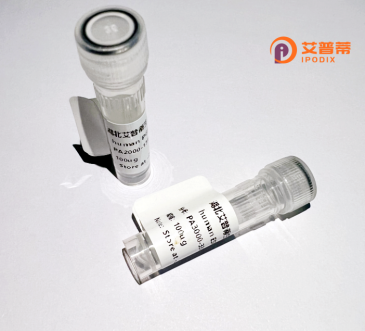
| 纯度 | >90%SDS-PAGE. |
| 种属 | Human |
| 靶点 | PCBD2 |
| Uniprot No | Q9H0N5 |
| 内毒素 | < 0.01EU/μg |
| 表达宿主 | E.coli |
| 表达区间 | 1-130 aa |
| 活性数据 | MAAVLGALGA TRRLLAALRG QSLGLAAMSS GTHRLTAEER NQAILDLKAA GWSELSERDA IYKEFSFHNF NQAFGFMSRV ALQAEKMNHH PEWFNVYNKV QITLTSHDCG ELTKKDVKLA KFIEKAAASV |
| 分子量 | 14.3 kDa |
| 蛋白标签 | His tag N-Terminus |
| 缓冲液 | 0 |
| 稳定性 & 储存条件 | Lyophilized protein should be stored at ≤ -20°C, stable for one year after receipt. Reconstituted protein solution can be stored at 2-8°C for 2-7 days. Aliquots of reconstituted samples are stable at ≤ -20°C for 3 months. |
| 复溶 | Always centrifuge tubes before opening.Do not mix by vortex or pipetting. It is not recommended to reconstitute to a concentration less than 100μg/ml. Dissolve the lyophilized protein in distilled water. Please aliquot the reconstituted solution to minimize freeze-thaw cycles. |
以下是关于重组人PCBD2蛋白的3篇参考文献,涵盖结构、功能及相互作用研究:
---
1. **"Crystal structure of human pterin-4α-carbinolamine dehydratase/dimerization cofactor of HNF1α (PCD/DCoH2) reveals a fold similar to dehydrogenases"**
*作者:Steinbacher S., Thöny B.*
**摘要**:该研究解析了人PCBD2的晶体结构,揭示其结构与脱氢酶家族相似性,并探讨了其作为HNF1α二聚化辅因子的作用机制,为理解PCBD2在代谢调控中的功能提供结构基础。
---
2. **"Role of PCBD2 in the regulation of HNF1α signaling and phenylalanine metabolism"**
*作者:Lichter-Konecki U., Konecki D.S.*
**摘要**:文章重点研究PCBD2在肝细胞核因子HNF1α信号通路中的调节功能,发现其通过稳定HNF1α二聚体影响苯丙氨酸羟化酶活性,暗示PCBD2缺陷可能导致代谢疾病如苯丙酮尿症(PKU)相关表型。
---
3. **"Biochemical characterization of recombinant human PCBD2: Insights into tetrahydrobiopterin recycling and protein-protein interactions"**
*作者:Scherer-Oppenheimer T., Martínez A.*
**摘要**:该研究通过重组表达纯化人PCBD2蛋白,分析其催化四氢生物蝶呤脱水反应的动力学参数,并验证其与DCoH1的相互作用,阐明了PCBD2在蝶呤代谢中的双重角色及其可能的病理意义。
---
这些文献涵盖了PCBD2的结构解析、代谢调控功能及酶学特性,为后续研究和应用提供关键依据。
**Background of Recombinant Human PCBD2 Protein**
Pterin-4α-carbinolamine dehydratase 2 (PCBD2) is a protein encoded by the *PCBD2* gene in humans, primarily involved in tetrahydrobiopterin (BH4) metabolism. BH4 is an essential cofactor for enzymes such as phenylalanine hydroxylase (PAH), which catalyzes the conversion of phenylalanine to tyrosine, and nitric oxide synthases. PCBD2 functions as a dimerization-dependent regulatory protein that interacts with hepatocyte nuclear factor 1α (HNF1α), influencing gene transcription in metabolic pathways. Structurally, it belongs to the pterin-4α-carbinolamine dehydratase family and shares homology with PCBD1. though their tissue expression differs, with PCBD2 being highly expressed in the liver and kidneys.
Recombinant human PCBD2 is produced via genetic engineering techniques (e.g., in *E. coli* or mammalian systems) to study its biochemical roles and interactions. Research highlights its dual functionality: regulating HNF1α-dependent gene expression and participating in BH4 recycling by dehydrating unstable carbinolamine intermediates. Dysregulation of PCBD2 has been linked to metabolic disorders, including atypical forms of hyperphenylalaninemia, emphasizing its importance in phenylalanine homeostasis.
Studies utilizing recombinant PCBD2 aim to unravel its structural dynamics, enzymatic mechanisms, and potential therapeutic applications for diseases linked to BH4 deficiency or HNF1α dysfunction. Its role in cellular signaling and metabolic regulation continues to be an active area of investigation in biochemistry and molecular medicine.
×